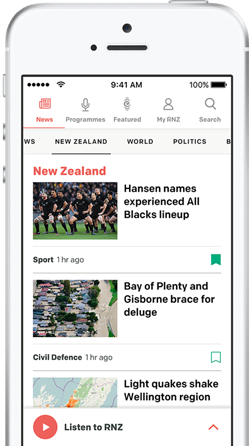
RNZ chief executive Paul Thompson Photo: RNZ / Dom Thomas
The biggest challenge for all media organisations is adapting to ever-changing audience habits and needs. It's been the key to RNZ's success throughout our 100 years. It was top of mind in 2014 when I gave a "call-to-arms" speech in Glasgow that set a new vision for RNZ to become a successful multimedia organisation. I saw this shift as essential if we were to deliver our public media charter effectively and efficiently to more New Zealanders.
At the time RNZ was definitely Radio New Zealand, with almost all our audience engagement coming from broadcast radio and online radio content. Back then, we reached around 15 percent of New Zealanders. I knew we needed to do more to adapt to people who were interested in our trusted news and entertainment but wanted the option of connecting with us on our website and social platforms.
In the speech I also talked about the risk of radio becoming less popular as audiences spent more time on the other platforms.
So where are we now?
Audiences have continued to move to digital consumption. Those who were children at the start of the digital age - the so-called digital natives - are now in their 40s. Their children know nothing else, while their grandparents are likely on their phones, too, and probably also listening to a radio station and watching the 6pm news.
The digital shift has left no audience demographic untouched, let alone any media organisation or wider society. Think about its impact everywhere - from how you bank, to healthcare and how we educate and communicate with each other.
RNZ has adapted successfully to this challenge by becoming the multi-media organisation that I envisaged. We want to give people high quality news, information and entertainment where they like to spend their time - and we're confident enough to realise that's not always on our platforms.
So, today, while you can engage with RNZ through the radio, on our website, apps and social channels, you'll also find our unique content on dozens of partner platforms. It's giving life to our public media charter which asks us to: serve the public interest; play an essential role in freedom of thought and expression; foster a sense of national identity and provide reliable, independent, and freely accessible news and information.
It has worked. We now reach and engage with around 80 percent of New Zealanders (18-plus) monthly - a big change in 11 years. In pure numbers, that audience of around 600,000 in 2014 has grown to more than 3m today. That's a much stronger return on the investment we get from taxpayers.
The role RNZ plays in the wider media ecosystem has grown too, especially as it is estimated that New Zealand now only has a quarter the journalists it had 15 years ago. RNZ-funded services like the Local Democracy Reporting scheme and RNZ Asia, ensure people have the information they need to play an active role in society while increasing mutual understanding and knowledge. Our new Podcast, Video and Life sections reflect the expanded range of the work we now do.
But our growth in these areas doesn't mean we should turn our back on the fabulous medium that is audio. While radio listening is slowly falling, it remains an essential part of the media landscape and of RNZ's DNA. Indeed, the beauty of great audio has found a whole new life via podcasting and on-demand listening. The truth is, that more people are listening to audio than before. Their habits have just been changing: from live to on-demand, from a broadcast to the many to the often very personal experience of a podcast.
We have three radio stations. RNZ National and RNZ Concert in New Zealand and RNZ Pacific for international audiences. They are big engines for content that appears across a range of our platforms (and which is shared with partners). They are beloved by many who have a lifelong relationship with the stations. During crises and emergencies, they come into their own as vital information lifelines.
We remain committed to doing a great job for our listeners, including by addressing a decline in RNZ National's audience. That is why we are working hard on a new Audio Plan to improve audience engagement on the station while also doing more to connect with listeners through podcasting and digital audio platforms.
The plan includes appointing a new chief audio officer to lead this work, ensuring the station prioritises the needs of the available audience, lifting on-air standards through enhanced staff training and support and ensuring we have a growing presence in the largest market of Auckland. It's another "call to arms", just like I made in Glasgow in 2014. And I am confident the dedicated and talented team at RNZ will again rise to the challenge.





